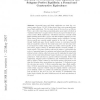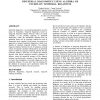886 search results - page 24 / 178 » Learning Distance Functions using Equivalence Relations |
CORR
2007
Springer
13 years 9 months ago
2007
Springer
Abstract. Sequential game and Nash equilibrium are basic key concepts in game theory. In 1953, Kuhn showed that every sequential game has a Nash equilibrium. The two main steps of ...
COMPGEOM
2011
ACM
13 years 1 months ago
2011
ACM
Starting with a similarity function between objects, it is possible to define a distance metric (the kernel distance) on pairs of objects, and more generally on probability distr...
WWW
2004
ACM
14 years 10 months ago
2004
ACM
This paper presents a novel approach of using web log data generated by course management systems (CMS) to help instructors become aware of what is happening in distance learning ...
NN
2008
Springer
13 years 9 months ago
2008
Springer
Currently, there is a lack of general-purpose in-place learning networks that model feature layers in the cortex. By "general-purpose" we mean a general yet adaptive hig...
APPINF
2003
13 years 11 months ago
2003
Industrial diagnostics is an important application area for many AI formalisms. Temporal diagnostics, based on analyzing temporal relations between values of crucial variables, is...


